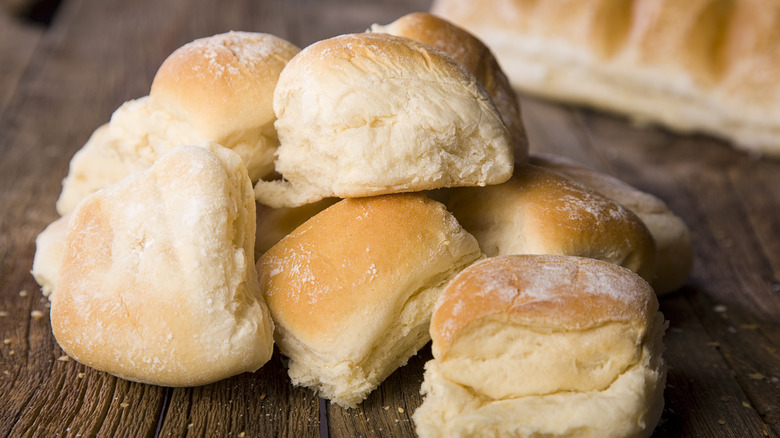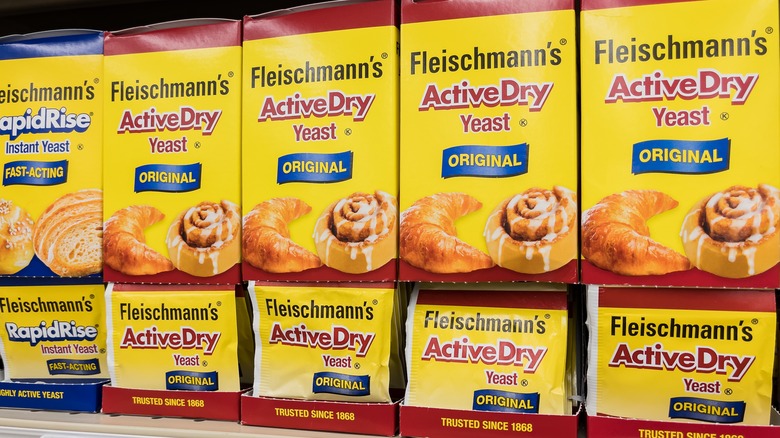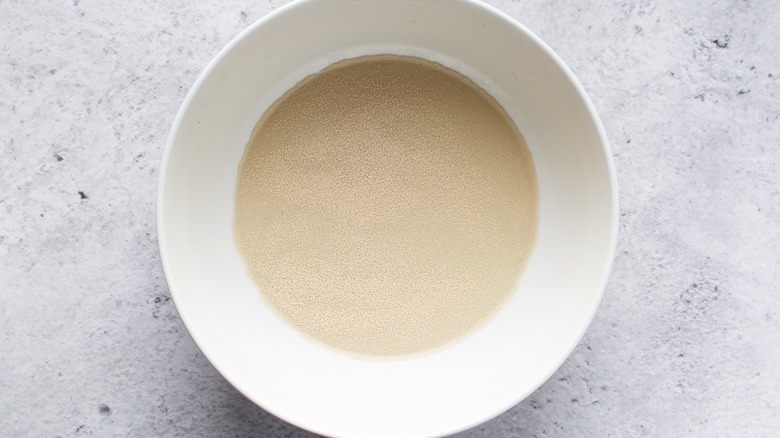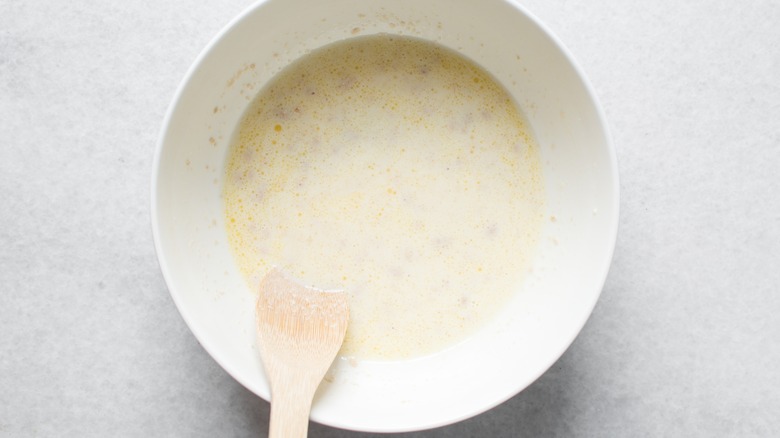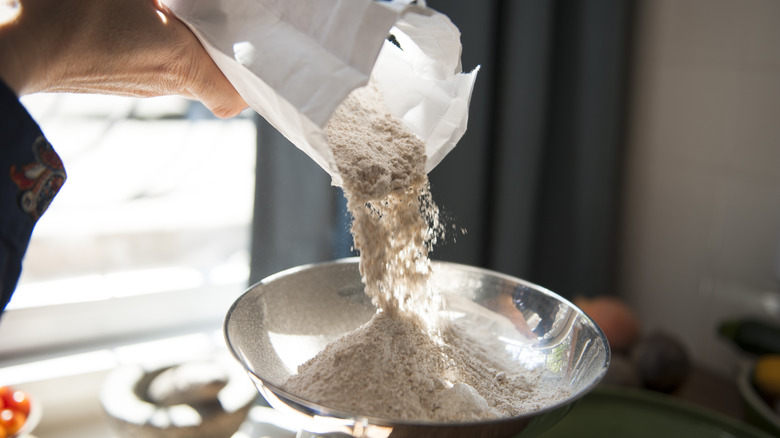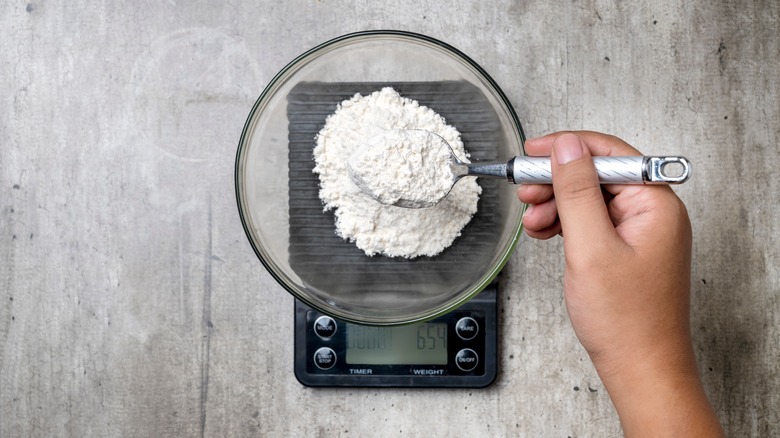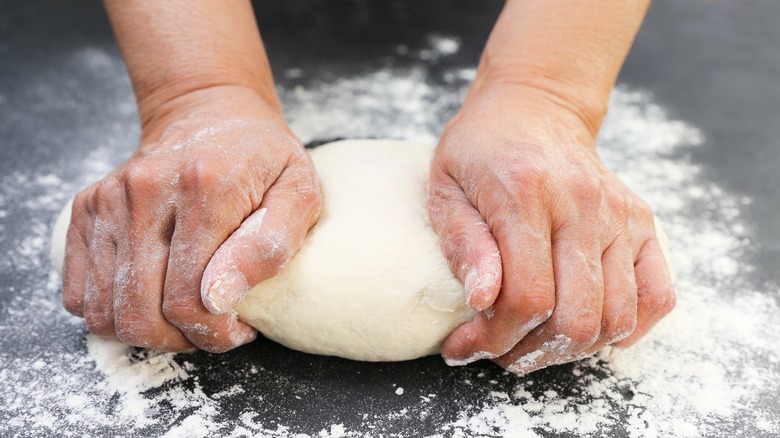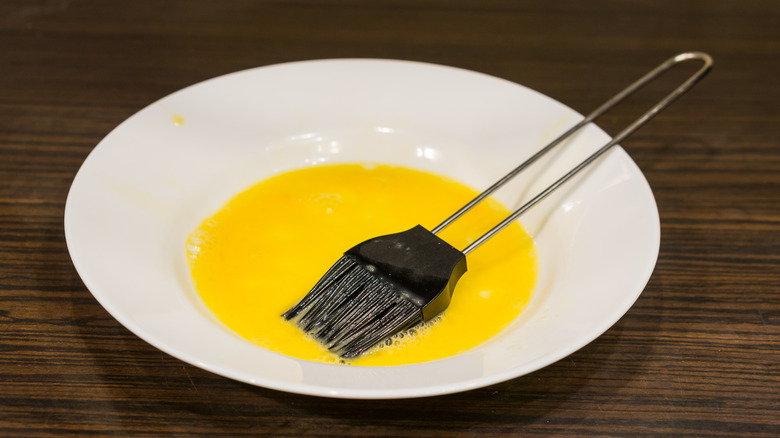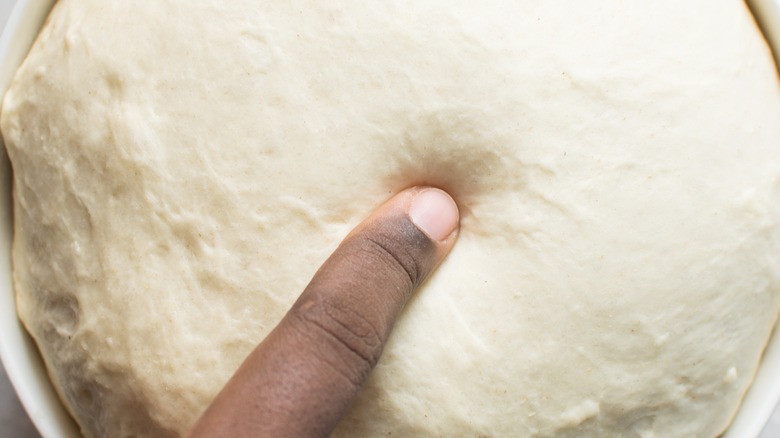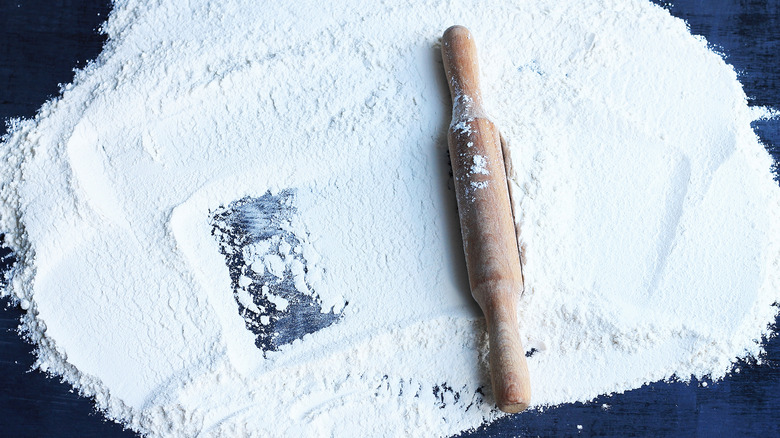Easy Mistakes Everyone Makes When Making Dinner Rolls
We may receive a commission on purchases made from links.
There's something irresistible about a warm dinner roll straight from the oven. Their soft, pillowy texture and buttery flavor make them a perfect accompaniment to any meal. They're also extremely versatile. You can serve them slathered in the best salty butter, use them to mop up delicious sauces, or add some herbs and spices into the mix for a tasty variation. However you enjoy these yeast rolls, making them from scratch can be a challenge.
Baking the perfect dinner rolls may seem straightforward, but even seasoned bakers can make simple mistakes that lead to less-than-ideal results. From under-proofing to over-flouring, there are missteps that can turn soft, golden brown rolls into tough, dense, or flat disasters.
Chef Melissa Weller, chemical-engineer-turned-professional-chef and author of the cookbook "Very Good Bread," weighed in with her tips to help bakers avoid common dinner roll pitfalls. She's put her scientific experience to use in the kitchen over the years and mastered the art of all things bread — dinner rolls included.
Using a yeast you're not familiar with
If you're a beginner bread baker, checking out the yeast options at your local supermarket can be overwhelming. There are several varieties of yeast available, from active dry and instant to fast-rising and even fresh yeast cakes in the refrigerated section. Choosing one can be a challenge if you don't know the difference them.
In short, yeast will help your rolls rise and offer the wonderful scents and flavors we associate with bread. Each type of yeast works a little differently, but the common purpose, to create light, fluffy rolls, is the same.
"When you're making dinner rolls at home, you should use the type of yeast that you're most comfortable with or have on hand," says chef Melissa Weller. In other words, just like how an important dinner party isn't the best time to experiment with new recipes, making dinner rolls for the holidays isn't the time try a new yeast. Weller recommends dried yeast for home baking but asserts that "one is not better than the other. They are just different, but can be used interchangeably."
Keep in mind that active dry yeast will take longer to rise than instant yeast. Some bakers also notice a difference in the level of yeasty flavor in dinner rolls and other breads, depending on the yeast they use.
Not testing the yeast
Yeast is a living thing — and like all living things, it can die. So, it's important to test your yeast before you add it to your dough to ensure it's alive and active. Otherwise, you'll risk baking bread that's dense, tough, and poorly-risen.
The process of testing yeast may also be referred to as "proofing" or "blooming." But, these terms can actually refer to two separate things, so you'll want to consult your recipe if you need clarification. "Proofing or blooming yeast can mean testing it to make sure it works before you add it to your dough or it can mean hydrating it by dissolving it in warm water before you use it," says Melissa Weller. Active dry yeast, which has larger granules, should be dissolved in a liquid before it's used. Instant yeast, which is more finely ground, can be added directly to the dough rather than mixed into the water.
You can test your yeast by stirring it into warm water with a little sugar. After a few minutes, it should thicken, bubble and give off a yeasty scent. If this doesn't happen, it's time to buy some new yeast.
Killing the yeast
It's easy to accidentally kill yeast even before adding it into your dinner roll dough. Dead yeast won't function properly and will leave you with flat, dense dinner rolls. Yeast is sensitive to heat, so it's imperative that you make sure that any liquids you add to your dough are at the right temperature. If your liquid's too cold, it won't activate the yeast, but if it's too hot, it will kill the yeast. Either way, you'll be left with poorly-risen rolls. Making sure your liquid is the right temperature can prevent this.
You can typically avoid killing your yeast by keeping your liquids between 100 F and 115 F, but this range can narrow depending on the type of yeast you're using. The liquid added to active dry yeast should be between 100 F and 110 F. Bread machine, RapidRise, or instant yeast can withstand temperatures between 120 F and 130 F. It's best to rely on a thermometer to test the temperature of your liquids. But if you don't have one, you can make sure your liquid is warm to the touch, but not too hot.
Choosing the wrong flour
All purpose, self-rising, whole wheat, cake flour, pastry flour — these are just a few of the types of flour you'll find in your grocery store's baking aisle. Each serves a specific purpose, so it's crucial that you select the right one for making dinner rolls. The flour you choose will affect the structure and texture of your finished product.
The key difference between most of these flours is the amount of protein they contain. Protein is directly correlated to gluten. And, the more gluten in the flour, the stronger the resulting dough will be. You'll want to use flours with less protein for lighter baked goods, like cakes and muffins, and higher protein flours for breads. Cake flour contains less protein then other flours, which is why cakes made with it are light and tender. Bread made with cake flour would not have the proper texture and vice versa.
All purpose flour typically contains between 9 and 11% protein, while bread flour can contain between 11 and 13%. This may not seem like a big difference, but that small percentage will have a big impact on the texture of your rolls. "I like to use a bread flour in the range of 12 to 13% protein when I make dinner rolls," says Melissa Weller. "King Arthur all-purpose flour has a protein content of 11.7%, which I find perfect for dinner rolls."
Not measuring the flour correctly
Measuring flour might seem like easy work, but if you use the wrong measuring technique, the amount you're adding to the recipe may be more or less than you thought it was. This can lead to less-than-stellar dinner rolls and other baked goods. Too much flour can make the rolls dense and tough, and too little will yield a sticky, overly soft dough that may not hold its structure when it's baked.
For most cooks, measuring flour means grabbing a measuring cup and scooping out the desired amount. Unfortunately, this might be the worst way to measure flour. Scooping can compact the flour in the measuring cup and pack it down — which means you will end up with more in your cup than you need. For the best results, ditch the scoop and either spoon the flour into the measuring cups or weigh it out.
The spoon-and level-method of measuring, which involves using a spoon to add flour to the measuring cup and a butter knife to level off the top, gives you a better chance of getting the amount right, but weighing your flour is still the best option. Chef Melissa Weller agrees. "Bakers should always weigh their flour." she says. "It is a much more precise way to make bread and leaves no room for variations in how the volume is measured."
Over-kneading the dough
Kneading is a crucial part of making dinner rolls. It activates and makes the gluten stronger. Plus, itensures all of the ingredients are evenly distributed throughout the dough. However, you'll need to knead with caution because over-kneading your dough can cause problems. Over-kneading is more likely to occur when you're using a stand mixer to build your dough, but it is possible to overdo it by hand too. Over-kneaded dough will end up tight and stiff. Plus, your bread may tear more easily or bake up hard and dense.
Properly kneaded dough is soft and elastic and will spring back when it's touched when touched gently. To avoid over-working your dough, Melissa Weller has two recommendations. "Try not to overthink it and follow the recipe," she says. A good recipe will give you a time limit for kneading and will share things to look for that indicate you've kneaded it enough. Weller also recommends doing a windowpane test. When a piece of dough is stretched out, it shouldn't tear, but instead should be transparent — like a windowpane. Getting the kneading time right will give you the delicate and soft dinner rolls of your dreams.
Skipping the egg wash
Dinner rolls with a perfect, golden brown finish are not just a happy accident. Yes, the heat from the oven will give them a little color, but to get that bake shop luster, you'll need to whisk up an egg wash. An egg wash is a mixture of beaten egg and a small amount of liquid, typically water or milk, that is brushed onto baked goods before baking. It gives the rolls the brown sheen that makes them so mouthwatering to look at. Egg wash can also serve as a glue that helps toppings, like sesame seeds, stick to the rolls. Learning how to use egg wash properly can elevate your dinner rolls and other baked goods by giving them a professional look and finish.
You can use whisk water or cream into your eggs to get the ideal color and gloss. Mix an egg with water for a dark brown color and a soft crust. For more sheen and less color, use milk or cream instead of water. Use only the egg white with water for a firmer crust without too much color and stick to only the yolk if a deeper, darker brown is what you're looking for.
Proofing the dough too long or not long enough
Properly proofed dinner roll dough will rise well. Once you've shaped your rolls and tucked them into your baking dish, the final step before baking them is to put them in a warm, dry spot and give them time to rise. The rising occurs when the yeast feeds on the sugar in the dough and then produces carbon dioxide, which causes the bread to expand. As easy as this may sound, for some bakers, proofing is the hardest bread-baking step. It's possible to mess it up and ruin your rolls by either under or over-proofing the dough.
Under-proofed dough will have an uneven texture with a mix of large pockets of air and thick, dense dough. Over-proofed dough will run out of sugars too soon. The gluten will start to deteriorate and the dough won't rise when it's baked.To proof your dough just right, you can try a simple poke test. Your bread is properly proofed when you touch it gently with a lightly oiled or floured finger and the dough springs back slowly. A fast spring back means they need more time.
Melissa Weller recommends bakers choose their proofing location wisely. "I like a place close to my stove where there is a little warmth from my oven," she says. Getting the proofing right helps rolls rise and achieve the light, airy texture everyone wants.
Using too much flour
Incorporating too much flour into dinner roll dough is a common mistake and one that makes dinner rolls hard as rocks. Unfortunately, it can be easy to do, since you'll need to make dough that's not too sticky nor wet. You should only be using just enough flour to prevent it from sticking to the rolling pin or your hands, Melissa Weller shares.
"Follow the recipe and weigh your ingredients," Weller says. She explains that while some recipes will give you a range of flour amounts, you should always start with a little bit, then add more based on its texture. "I add a little bit at a time and never go over the amount a recipe calls for," she says. If your dough is still sticky after you've added the amount of flour the recipe calls for, add additional flour gradually, one tablespoon at a time, until the dough is no longer wet.
